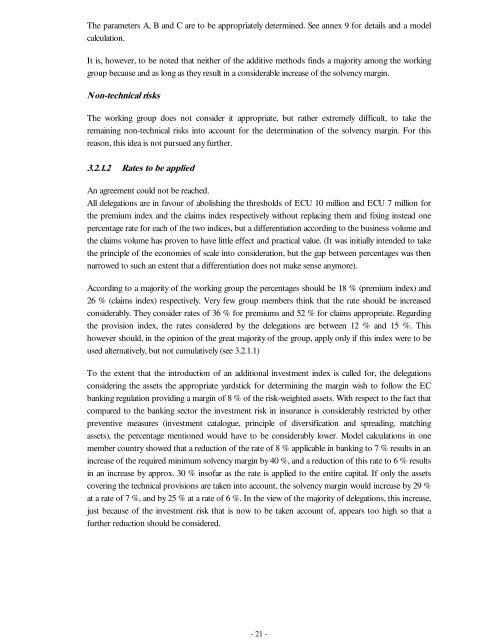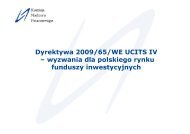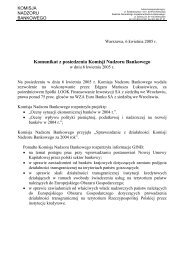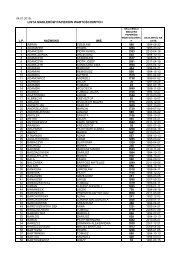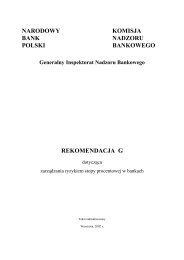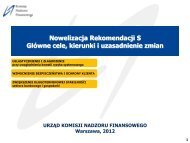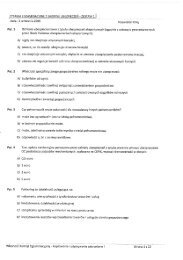Solvency of Insurance Undertakings (Mueller-Report) - Eiopa
Solvency of Insurance Undertakings (Mueller-Report) - Eiopa
Solvency of Insurance Undertakings (Mueller-Report) - Eiopa
You also want an ePaper? Increase the reach of your titles
YUMPU automatically turns print PDFs into web optimized ePapers that Google loves.
The parameters A, B and C are to be appropriately determined. See annex 9 for details and a modelcalculation.It is, however, to be noted that neither <strong>of</strong> the additive methods finds a majority among the workinggroup because and as long as they result in a considerable increase <strong>of</strong> the solvency margin.Non-technical risksThe working group does not consider it appropriate, but rather extremely difficult, to take theremaining non-technical risks into account for the determination <strong>of</strong> the solvency margin. For thisreason, this idea is not pursued any further.3.2.1.2 Rates to be appliedAn agreement could not be reached.All delegations are in favour <strong>of</strong> abolishing the thresholds <strong>of</strong> ECU 10 million and ECU 7 million forthe premium index and the claims index respectively without replacing them and fixing instead onepercentage rate for each <strong>of</strong> the two indices, but a differentiation according to the business volume andthe claims volume has proven to have little effect and practical value. (It was initially intended to takethe principle <strong>of</strong> the economies <strong>of</strong> scale into consideration, but the gap between percentages was thennarrowed to such an extent that a differentiation does not make sense anymore).According to a majority <strong>of</strong> the working group the percentages should be 18 % (premium index) and26 % (claims index) respectively. Very few group members think that the rate should be increasedconsiderably. They consider rates <strong>of</strong> 36 % for premiums and 52 % for claims appropriate. Regardingthe provision index, the rates considered by the delegations are between 12 % and 15 %. Thishowever should, in the opinion <strong>of</strong> the great majority <strong>of</strong> the group, apply only if this index were to beused alternatively, but not cumulatively (see 3.2.1.1)To the extent that the introduction <strong>of</strong> an additional investment index is called for, the delegationsconsidering the assets the appropriate yardstick for determining the margin wish to follow the ECbanking regulation providing a margin <strong>of</strong> 8 % <strong>of</strong> the risk-weighted assets. With respect to the fact thatcompared to the banking sector the investment risk in insurance is considerably restricted by otherpreventive measures (investment catalogue, principle <strong>of</strong> diversification and spreading, matchingassets), the percentage mentioned would have to be considerably lower. Model calculations in onemember country showed that a reduction <strong>of</strong> the rate <strong>of</strong> 8 % applicable in banking to 7 % results in anincrease <strong>of</strong> the required minimum solvency margin by 40 %, and a reduction <strong>of</strong> this rate to 6 % resultsin an increase by approx. 30 % ins<strong>of</strong>ar as the rate is applied to the entire capital. If only the assetscovering the technical provisions are taken into account, the solvency margin would increase by 29 %at a rate <strong>of</strong> 7 %, and by 25 % at a rate <strong>of</strong> 6 %. In the view <strong>of</strong> the majority <strong>of</strong> delegations, this increase,just because <strong>of</strong> the investment risk that is now to be taken account <strong>of</strong>, appears too high so that afurther reduction should be considered.- 21 -


